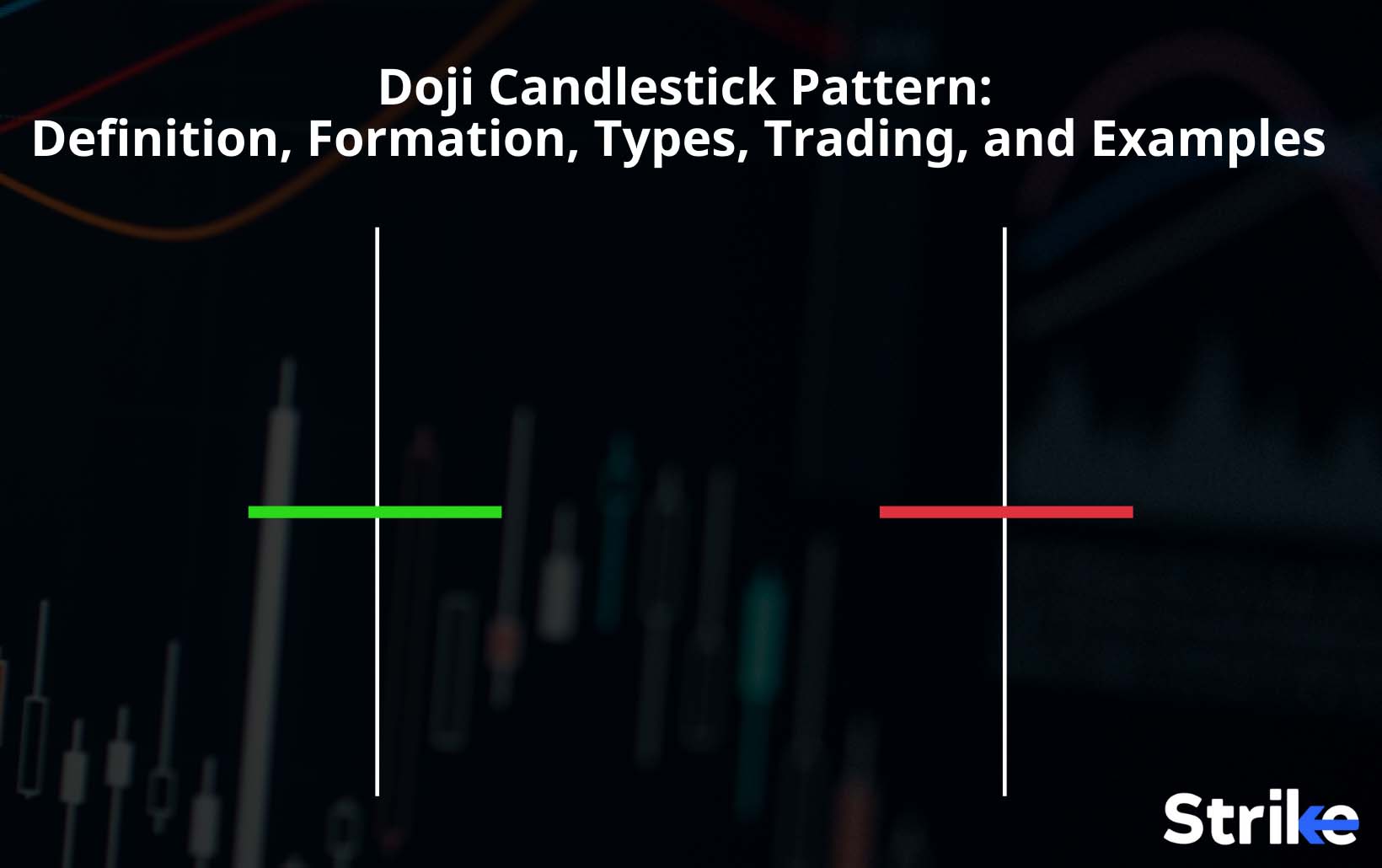
Doji is a type of price chart pattern in which the opening and closing prices of security are practically equal. Doji candlestick patterns resemble a plus sign or a cross owing to the equal open and close price. Doji candlesticks are formed when a security price opens, fluctuates to a high and low and then closes at a point that is the same level as the opening price.
Doji candlestick patterns are of six main types including the gravestone doji, the long-legged doji, the dragonfly doji, the standard doji, the 4-price doji and the neutral doji. Doji candlesticks are classified depending on the position of the horizontal open-close price line. All six types of doji happen when the opening and closing price of a particular security falls on the same level on the price chart.
Doji patterns are read and interpreted based on the type of doji that appears on the price chart. There are three principal ways of interpreting doji patterns which include indecision, a continuation of the present trend and a possible trend reversal. To trade with doji candlestick patterns, investors and traders first determine the type of doji pattern that is present and then decide on the trading strategy. The two commonly used strategies for doji patterns include stop-loss orders and shorting.
The four main advantages of doji patterns include their ability to guide investors through possible trend reversals, ease of identification, accuracy and their ability to be used in all timeframes. Doji candlestick patterns also involve two primary disadvantages including the tendency to produce false positives and the waiting period it takes to confirm the upcoming market trends it signals. Other popular candlestick patterns include spinning top, shooting star, hammer, hanging man, evening star etc.
What exactly is a Doji Candlestick?
A doji is a pattern that is formed in candlestick price charts wherein the opening and closing price of a security is equal or show very minute variation. Doji candlesticks derive their name from the Japanese term ‘doji’ which means a mistake, or error, referring to the rare chance of a security having an equal or almost equal opening and closing price. Doji candlesticks are principally considered neutral signals that reflect the state of indecision existing in the market. A doji candlestick pattern is shaped like a plus sign or a cross. The lengths of the horizontal and vertical lines of a doji candlestick vary depending on the opening price, the high, the low and the closing price. The image below shows the basic structure of a doji candlestick.
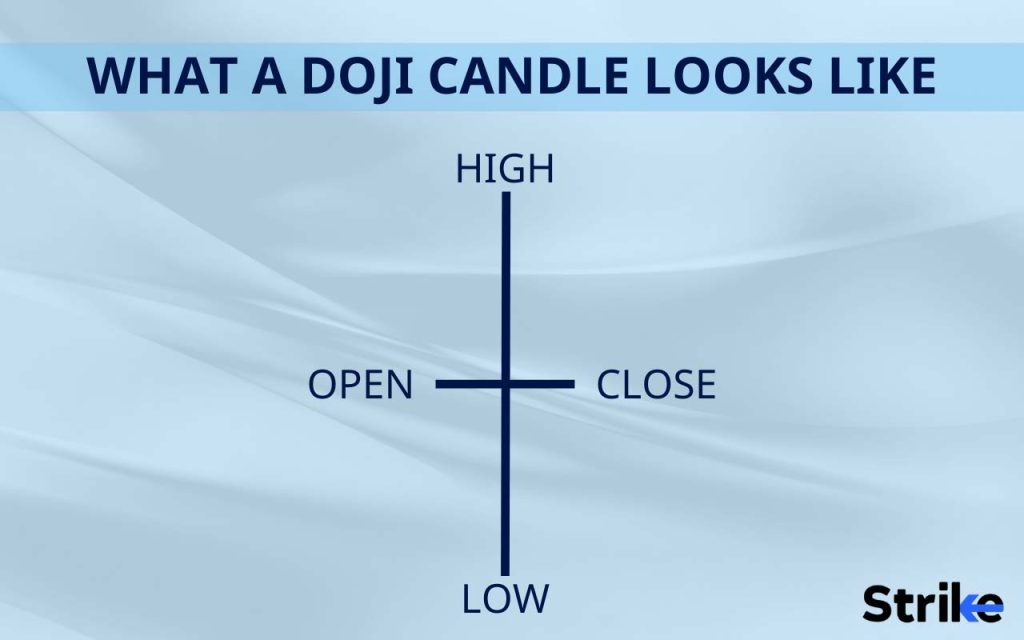
As seen in the image above, the doji candlestick pattern resembles a plus sign or a cross symbol. The upper tip of the vertical line of the doji represents the highest price of the security for the day and the bottom tip represents the lowest price for the day. The horizontal line of the doji pattern has the closing price on one side and the opening price on the other side.
Doji patterns, most commonly, tell traders about the condition of indecision that is existing in the present market. However, certain investors and traders also use doji patterns to learn about the possibilities of trend reversals and the continuation of existing trends.
How is a Doji Candlestick Pattern Formed?
A doji candlestick pattern is formed when the opening price and closing price of a security are equal or fall very close to each other. Doji candlestick patterns are formed when the price of the security is first pushed to a high following the opening, only to be pushed down by the bears. The bears push the security price to a low, however, they are unable to maintain it as the bulls push the prices higher.
As a result of the push and pull between the bulls and the bears, the closing price ends up being equal to or very close to the opening price of the security.
A doji candlestick can be identified by its distinct shape which resembles a plus sign or a cross symbol. Investors and traders make interpretations about price movements when they witness the cross or plus-shaped doji candlestick. The image below depicts the three kinds of doji patterns and their colours based on opening and closing prices.
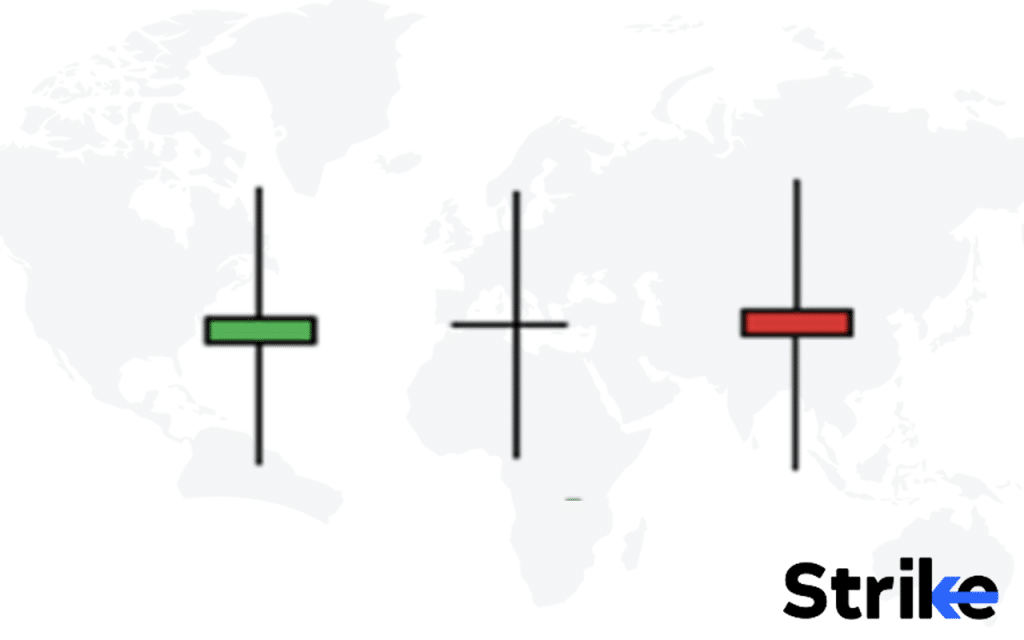
The first kind of doji is the green doji. The green body of a doji candlestick implies that the closing price was slightly higher than the opening price. The second kind is the red doji. The red body of the doji implies that the closing price was slightly lower than the opening price. Doji candlesticks can be red or green depending on the opening and closing price. The third and final kind of doji candlesticks are those which have no real body. These doji candlesticks comprise a single black single, indicating that the opening and closing prices are equal. Doji candlesticks are commonly found at the top and bottom of trends and signal possible trend reversals. However, they can also signal indecision or a continuation of the current trend.
What does Red Doji mean?
A red doji indicates that the closing price of the security is less than the opening price of the security. The difference between the opening and closing price is, however, very minute.
The image below shows a red doji.
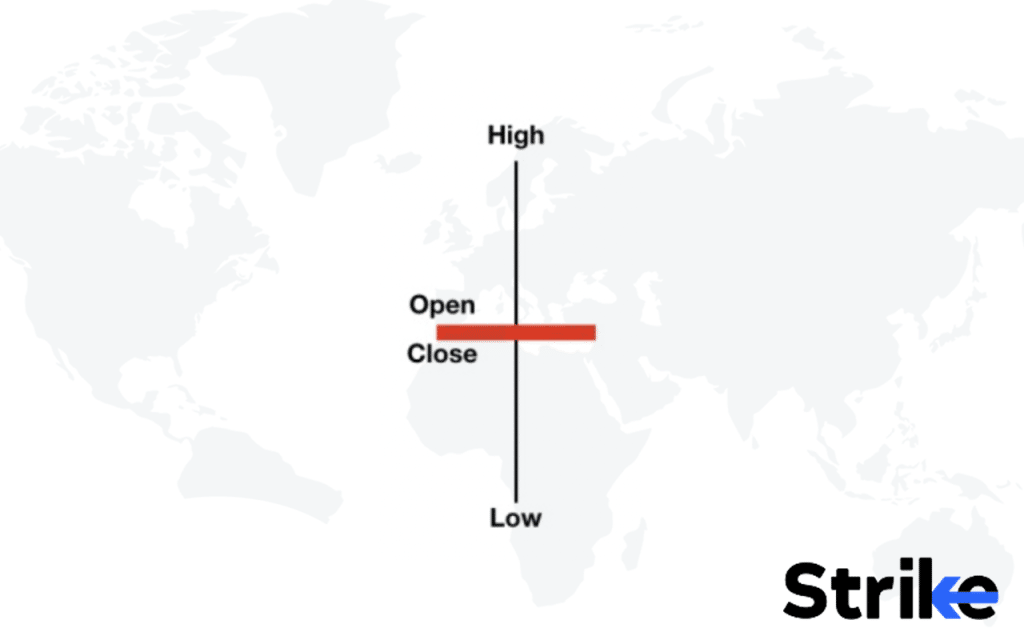
As portrayed in the image the opening price is slightly higher than the closing price, although the opening and closing prices of the security lie very close to one another. The red body of the doji candlestick is small owing to the minute difference between the opening and closing prices.
What does Green Doji indicate?
A green doji tells that the closing price of the security is more than the opening price of the security. The difference between the opening and closing price is, however, very small.
The image below depicts a green doji.
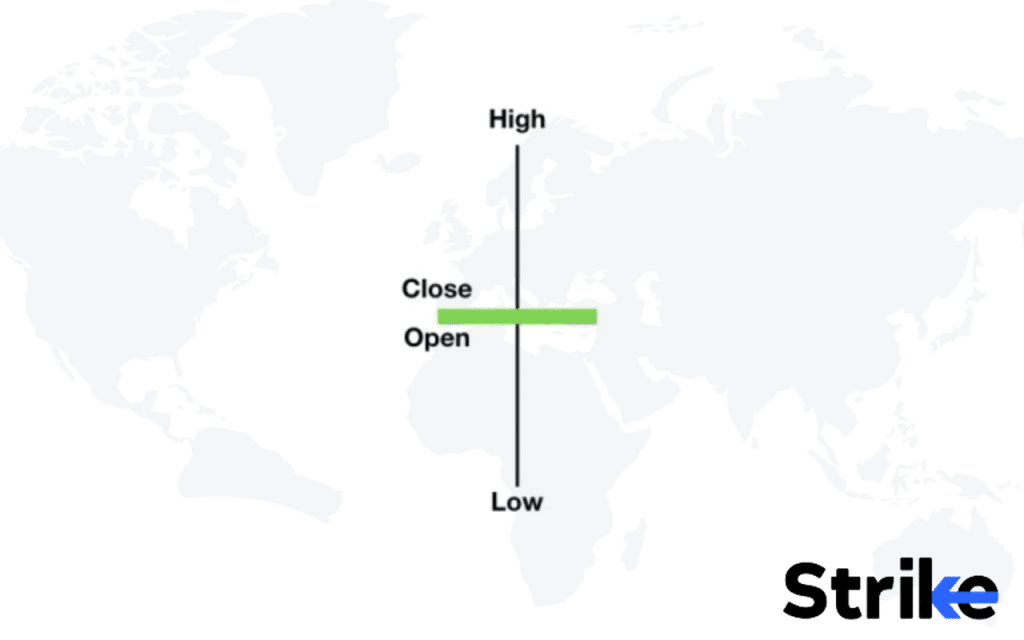
The image shows that the opening price is slightly lower than the closing price, although the opening and closing prices of the security lie very close to one another. The green body of the doji candlestick is thin as the difference between the opening and closing prices is only minute.
Does It Matter if A Doji Is Red or Green?
No, it does not matter if a doji is red or green as the difference between the opening and closing prices in doji candlesticks is very very minute. The small variation between the opening and closing price means that the real body of both red and green doji candlesticks are too thin to make any significant difference in the manner in which each is interpreted and analyzed.
What are the Types of Doji Candlestick Patterns?
The six main types of doji candlestick patterns are listed below.
1. Gravestone Doji
A gravestone doji is a doji candlestick pattern in which the opening price, lowest price and closing price fall very close to each other or coincide, while the highest price is far away from them. Gravestone doji patterns stand for bearish dominance. Gravestone doji patterns have a long upper shadow. A gravestone doji differs from other doji patterns in the position of the horizontal line. In gravestone doji patterns the horizontal line or body is placed towards the bottom of the vertical line. The image below depicts a gravestone doji.
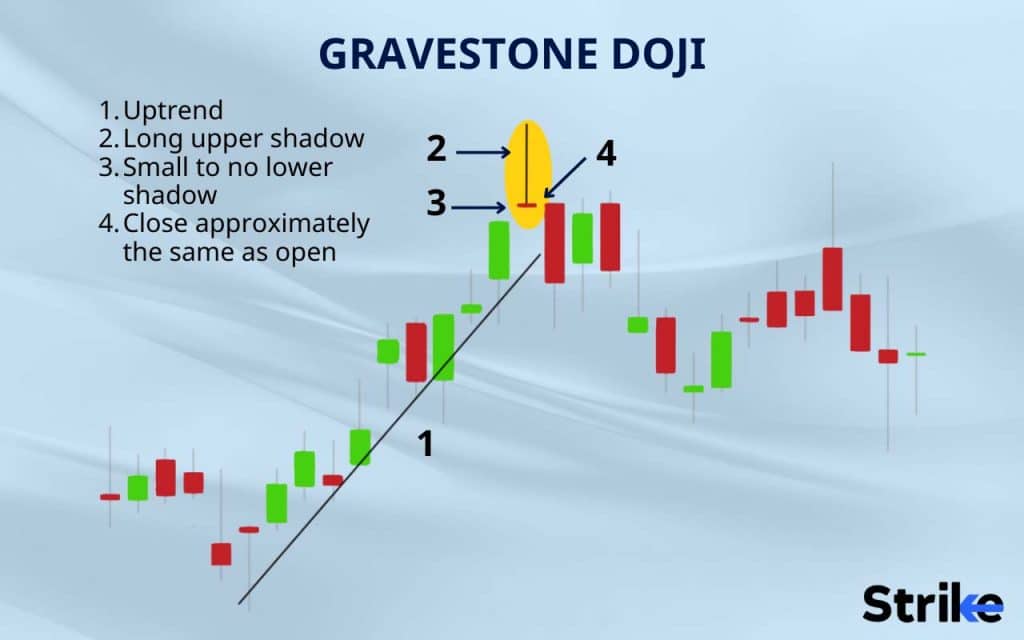
As depicted in the image, the gravestone doji pattern has it open, close and low price falling very close to one another. The high price falls much further away from the rest, at the tip of the long upper shadow. The long upper shadow stands for the buyers who held a strong position earlier on in the day only to lose their gains to the sellers towards the end of the day as the price is pushed down. As seen in the image above, a gravestone doji can be spotted by its distinct shape, with a long upper shadow and a small or almost absent lower shadow. Other types of doji patterns such as the dragonfly, the long-legged doji, and the standard doji all have long lower shadows, making the small or absent lower shadow a distinct and identifying feature of gravestone doji patterns.
Investors and traders use the gravestone doji as a sign of an upcoming bearish trend reversal as there is a significant difference between the highest price and the closing price for the day. Gravestone doji patterns commonly occur at the end of an uptrend.
As seen in the image the doji occurs at the end of the uptrend, and it is identified by its long upper shadow and almost absent lower shadow. The close, open and low all fall in positions coinciding with each other. As the image indicates, the gravestone doji patterns indicate an upcoming bearish reversal, as the prices start to decline after the appearance of the gravestone doji.
2. Dragonfly Doji
The Dragonfly doji is a candlestick pattern in which the open, high and close prices of a security either coincide or fall very close to each other, while the low price is far away from them. The dragonfly doji is considered the opposite of the gravestone doji and it stands for bullish dominance. Dragonfly doji patterns have a long lower shadow. A dragonfly doji differs from other doji patterns in the position of the horizontal line or body. In dragonfly doji patterns the horizontal line or body is placed towards the very top of the vertical line. The image below depicts a dragonfly doji.
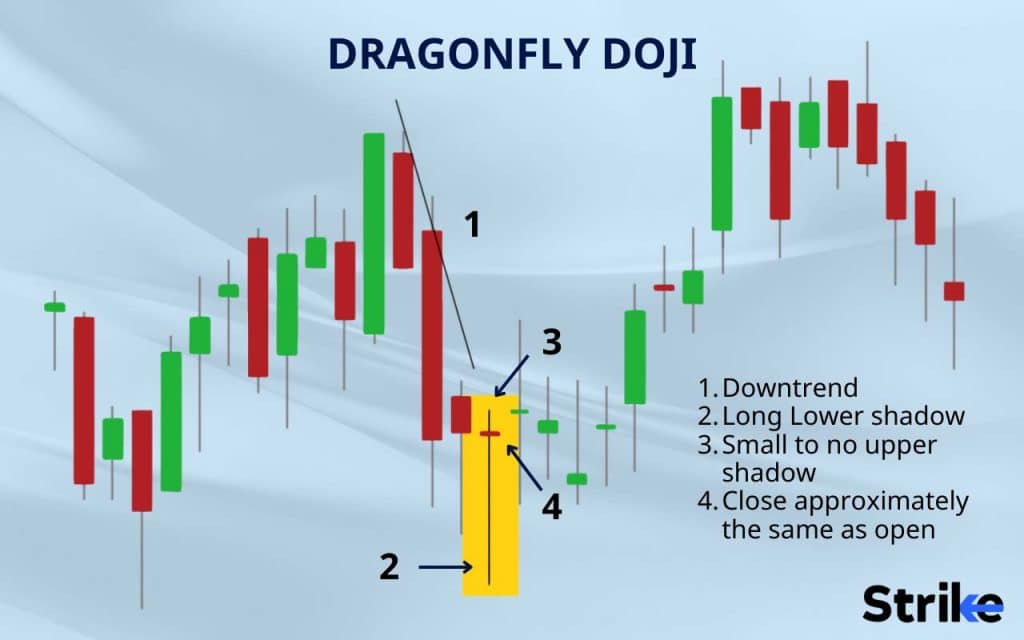
As depicted in the image, the dragonfly doji pattern has its open, close and low price falling very close to one another at the top of the candlestick. The low price falls much further away from the rest, at the tip of the long lower shadow. The long lower shadow stands for the buyers who dominated the sellers and pushed the price higher throughout the day. As depicted in the image above, a dragonfly doji is spotted by its distinct shape, with a long lower shadow and a small or almost absent upper shadow. Other types of doji patterns including the gravestone doji, the long-legged doji, and the standard doji all have longer upper shadows, making the small or absent upper shadow an identifying feature of the dragonfly doji pattern.
Investors and traders use the dragonfly doji as a sign of an upcoming bullish trend reversal. The long lower shadow is a sign that the demand is high in the market and that the bears were unsuccessful in dragging the price down. Dragonfly doji patterns commonly occur at the end of a downtrend and signal an upcoming bullish trend. An example of a dragonfly doji pattern is depicted in the price chart below.
The image shows that the doji occurs at the end of the downtrend, and it is identified by its long lower shadow. The close, open and high all fall in positions very close to each other, and there is a considerable distance between the low and the rest of the points. The image also indicates that the dragonfly doji pattern indicates an upcoming bullish reversal, as the prices start to advance after the appearance of the dragonfly doji.
3. Long legged Doji
The long-legged doji is a doji candlestick pattern in which the doji comprises long upper and lower shadows and the open and close prices of the security fall approximately close to one another. The long-legged stands for indecision with neither the bulls nor the bears adopting a dominating position. The long-legged doji represents indecision or uncertainty regarding the upcoming price movements. In a long-legged doji, the demand and supply are seen to equalize each other. The image below depicts a long-legged doji pattern.
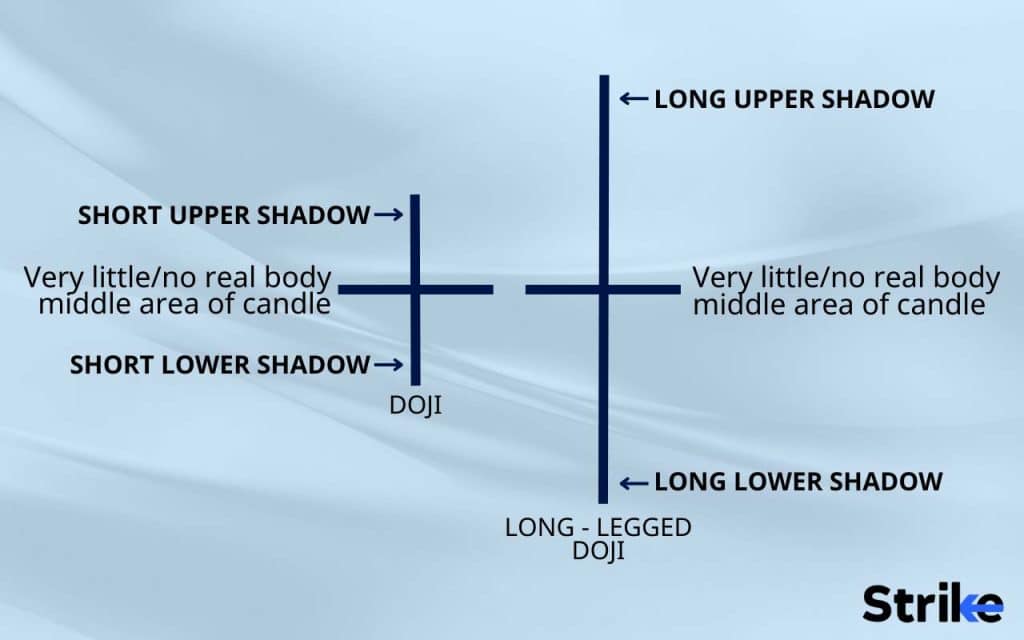
As the image depicts, the long-legged doji can be identified easily by its long upper and lower shadows and minutely small real body. The open and close prices of the security can be either equal or very close to each other. The long-legged doji is different from the other doji patterns in the position of the close-open horizontal line. In a long-legged doji, the horizontal line or body falls close to the middle of the two shadows.
A long-legged doji is used by investors and traders as a signal of uncertainty about upcoming price movements. The long upper and lower shadows signify the extremely high and low price points. However, the close price that coincides or falls very close to the opening price indicates that despite the long range of the price movement, the bears and bulls were unable to dominate and pull the prices higher or lower than the opening price. Some investors also interpret long-legged doji patterns as part of a consolidation period. A consolidation period refers to a period in a security’s price movement wherein the price fluctuates within a fixed support and resistance level. Long-legged doji is most often used when it appears during a strong bullish or bearish trend. In such cases, a long-legged doji tells the investors and traders that the supply and demand are balancing out each other and that a trend reversal may be imminent.
As an example of a long-legged doji, let us consider the price chart below.
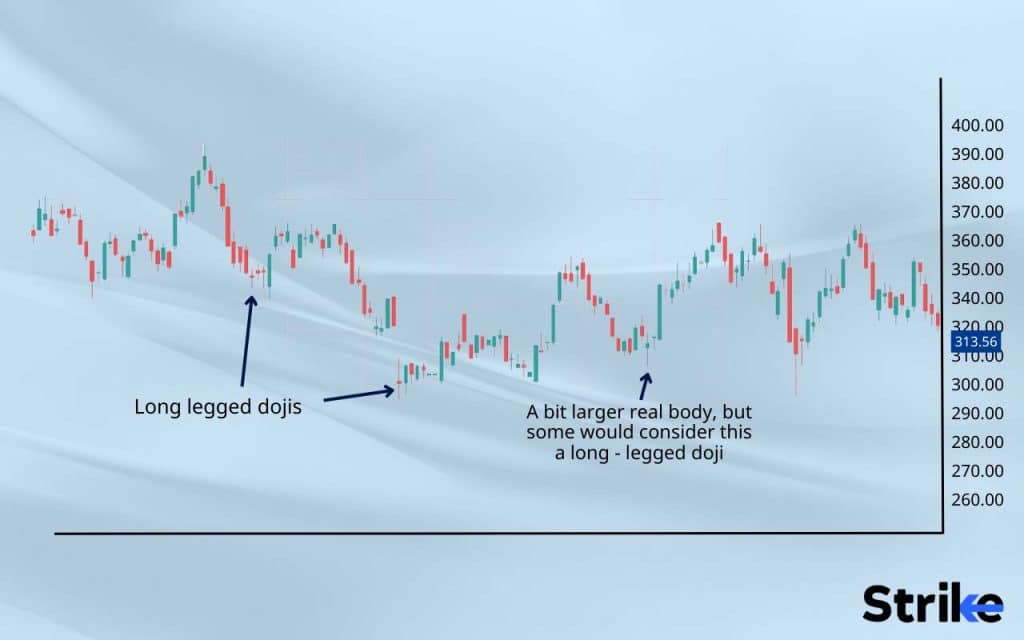
The image indicates that the long-legged doji appears at the end of a strong bullish trend. The long-legged doji can be spotted by its minutely thin body and long upper and lower shadows. Following the long-legged doji the price starts to decline, thereby signifying that the long-legged doji predicted a bearish trend reversal.
4. Standard Doji
A standard doji is a doji pattern that does not signify anything particular on its own. Standard doji is always interpreted depending on the patterns that come before and after it. A standard doji resembles a plus sign or a cross sign with upper and lower shadows of varying lengths depending on the low and high price. The image below shows a standard doji.
The image depicts the shape of the standard doji that resembles the plus or cross symbol. The length of the upper and lower depends on the high and low price of the security for the day. Standard dojis differ from the other doji patterns mainly in their interpretation. Standard doji patterns are interpreted and confirmed using the patterns appearing before and after it. Investors and traders use the standard doji in their technical analysis along with other indicators to learn about upcoming trends. An example of a standard doji has been detailed below.
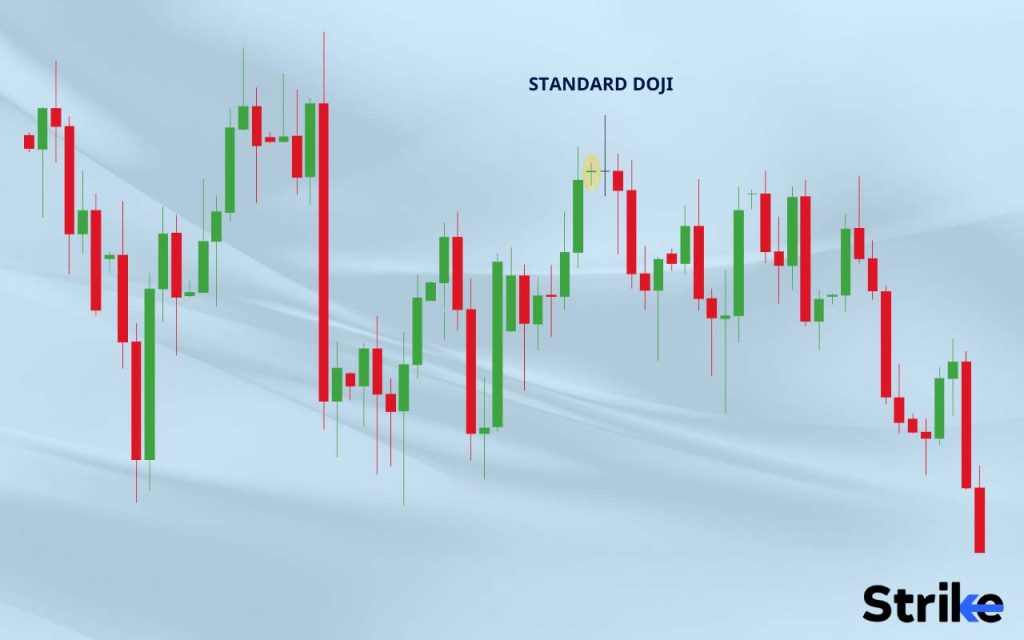
As seen in the image, the standard doji appears at the end of an uptrend. In such a case, investors and traders pay close attention to the patterns that follow it. Here, the pattern that follows depicts a downtrend. In this case, the standard doji stands for a bearish trend reversal.
5. 4-Price Doji
A 4-Price doji is a doji pattern in which the open, high, low and close prices of the security are all equal. A 4-price doji comprises just a horizontal line as the price fluctuation for the day is nil. 4-Price dojis represent indecision as the price undergoes no change. It can also reflect a lull in the market when the market is extremely quiet. The image below shows a 4-price doji pattern.
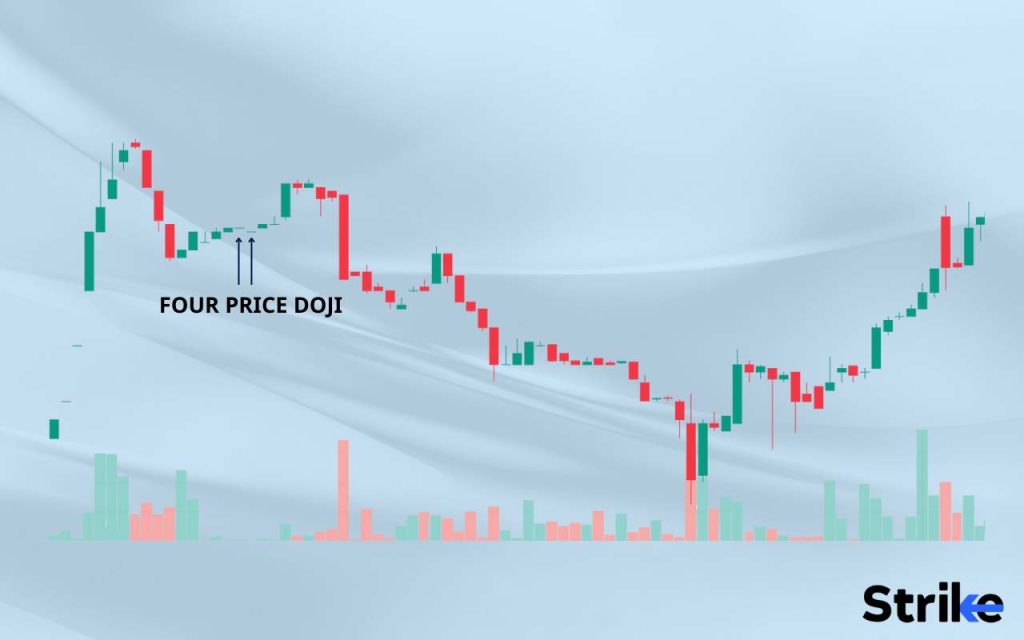
As seen in the image, the pattern comprises a single mere horizontal line. The open, high, low and close are all equal and fall on the same line. 4-price dojis differ from other patterns in that it is the only doji pattern with no vertical line as part of the pattern. 4-price dojis are easy to spot using their distinct shape which is a mere horizontal line.
Investors and traders interpret the 4-price doji as a sign of indecision and usually wait for the patterns that follow a 4-price doji before deciding on a trading strategy. An example of a 4-price doji has been given below.
As the image shows, at the end of the downtrend, there appear two 4-price dojis. These dojis reflect the uncertainty prevalent in the market sentiment at that point. Following the two 4-price dojis the price starts to increase. Investors plan strategies after the trend is confirmed.
6. Neutral Doji
The neutral doji is a doji pattern in which the opening and closing prices are the same and there exists a wide gap between the high and low prices. The upper and lower shadows of a neutral doji are equal in length. Neutral dojis are formed when the struggle between the bears and the bulls results in a standstill or pause. Neutral dojis can also signal trend reversals sometimes, but it does not happen every time and it is not an identifying feature of the neutral doji. The image of a neutral doji has been given below.
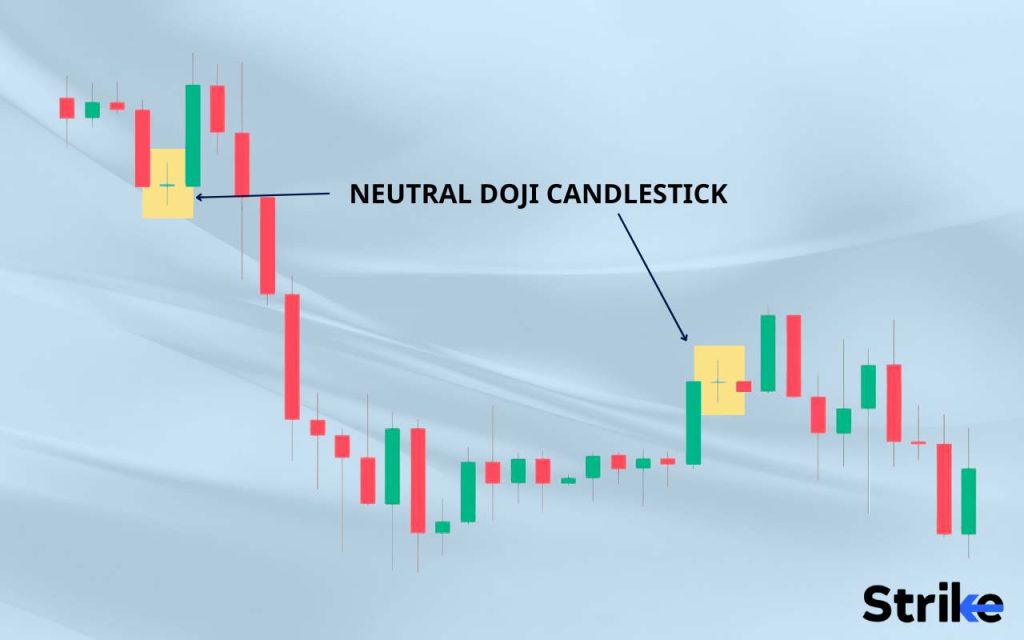
The images show that neural dojis have no real body as the opening and closing prices are the same. The two shadows are very widespread signifying a very high high-price point and low low-price point. The upper and lower shadows are equal in length and this signifies the indecision surrounding the neutral doji. It shows that after opening the price moved to a high up and then moved down to a low at about the same length, before closing at the same price as the opening price. Neutral dojis differ from the other doji patterns in how widespread their two shadows are.
Neutral dojis can appear anywhere on a price chart, be it in an uptrend or a downtrend.
In order to analyse a neutral doji accurately, investors and traders study the context in which it appears. The bearish trend is considered to be reversing when the neutral doji pattern appears at the end of a bearish trend and the bullish trend is considered to be reversing if it appears at the end of a bullish trend.
An example of a neutral doji has been detailed below.
The image depicts two scenarios in which neutral dojis have been formed. In the first, the neutral doji is formed in between a downtrend. Here the neutral doji indicates a pause in the active trend. As seen in the image after the one pattern that follows the neutral doji, the downtrend continues. In the second case, the neutral doji signifies indecision, as neither the bulls nor the bears are in a position to dominate.
Further classifications in doji types include the star doji, the bearish star doji, the bullish star doji, the hammer doji etc.
The most powerful Doji Candlestick pattern is the Dragonfly Doji. This pattern forms when the open, close, and high prices are the same, and the low price is significantly lower than the opening price. The resulting shape looks like a T with a long lower shadow and no upper shadow. The Dragonfly Doji signals a potential trend reversal from bearish to bullish when it appears after a downtrend. It indicates that the buyers have taken control after the selling pressure and that the price may start to rise. The pattern is more reliable when it occurs on high volume and is confirmed by other technical indicators such as trend lines, moving averages, and oscillators.
When does the Doji Candlestick Pattern happen?
A doji candlestick pattern happens when the open and close prices of a security either coincide or fall very close to each other. Doji candlesticks happen when there is a struggle between the bulls and the bears and neither succeeds in dominating the other. The bulls attempt to push the prices higher, while the bears attempt to pull them lower. As a result of this push and pull the security price closes very close to the open or sometimes even coincides with it. Doji candlesticks occur rarely.
How often does the Doji Candlestick Pattern occur?
Doji candlestick patterns are rare patterns which are not seen very commonly. They can be spotted before trend reversals or when there is a prevalent sentiment of indecision in the market. Investors and traders using this pattern prefer to use it along with other technical indicators to confirm trends.
How to read Doji Candlestick Pattern in Technical Analysis?
There are three main steps to reading doji candlestick patterns in technical analysis. The first step is identifying the doji pattern in the price chart. A doji pattern is roughly in the shape of a plus or cross sign with variations depending on the type of doji pattern. The image below depicts the main possible variations in doji types.
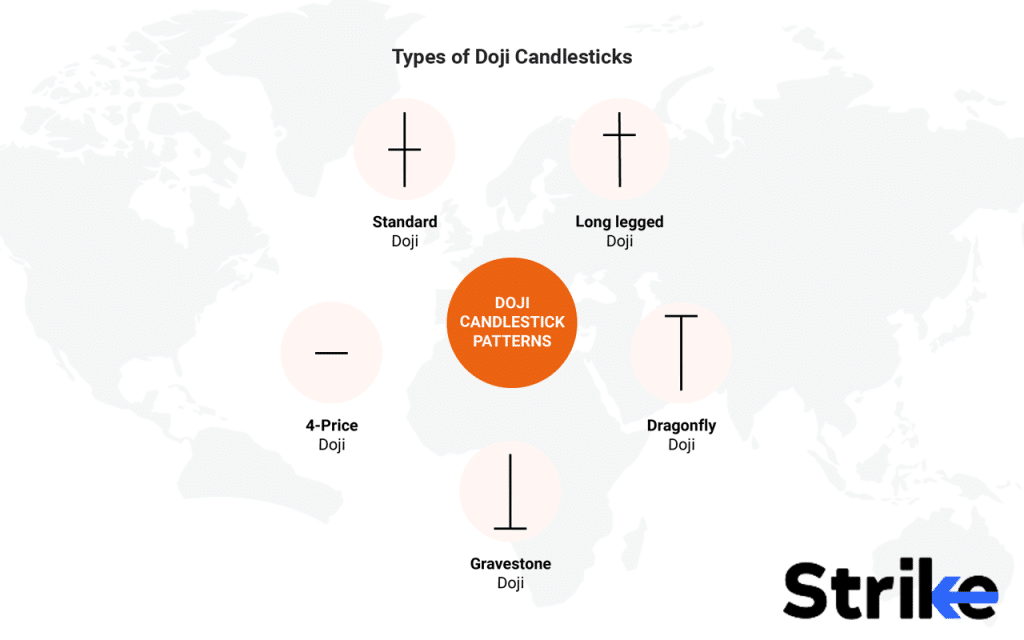
The image above depicts the various possible shapes doji candlesticks can take up. Investors and traders analyzing price charts look out for these shapes to identify the type of doji candlesticks. Depending on the type, the manner of interpretation varies. For instance, a gravestone doji predicts an upcoming bullish trend reversal, whereas the dragonfly predicts an upcoming bullish trend reversal and the 4-price doji indecision.
The second step in reading doji candlestick patterns is analyzing the contexts in which the doji candlesticks appear. Doji candlesticks that appear at the end of uptrends are considered to signal bearish trend reversals and those that appear at the end of downtrends, are bullish trend reversals. The doji patterns, particularly the 4-price doji or the neutral doji are considered signs of indecision.
The third and final step to reading doji candlestick patterns is confirming the analysis. To confirm the interpretation, investors and traders must analyze the patterns that follow the doji candlestick pattern. The image below depicts how doji candlesticks can be read and interpreted.
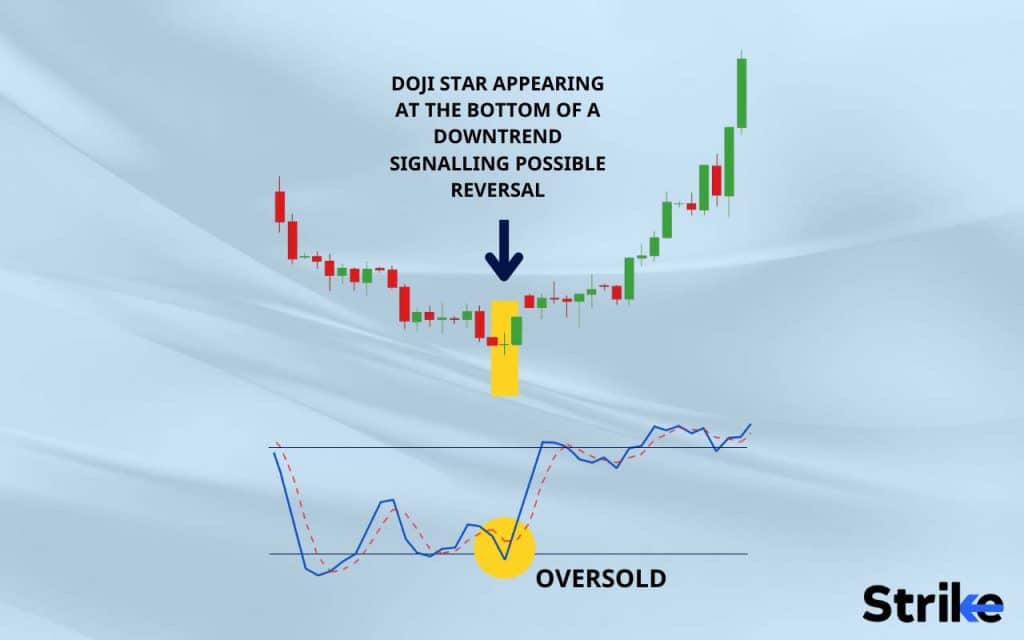
From the price chart above, the first step is to spot a doji candlestick. Here, a dragonfly doji can be spotted as seen in the circled portion of the image. The dragonfly doji can be identified by its long lower shadow and absent upper shadow. The open, high and close all coincide with one another.
The second step is the analysis of the context in which the doji appears. Here the analysis leads the investors and traders to understand that it has appeared at the end of a downtrend. As seen in the image, the prices were on a steady decrease when the dragonfly doji appeared, leading to the conclusion that it appears during a downtrend and signals a bullish reversal. Investors and traders must then move to the third step of confirmation. They must wait for the next two patterns that follow the doji to confirm the trend. As seen in the image, both the following candlesticks show an uptrend. The bullish reversal can now be confirmed and investors and traders can plan their strategy accordingly. The dragonfly doji here, is, thus, read as a signal of a bullish uptrend. Doji pattern results are accurate and reliable, upon confirming and using along with other technical analysis indicators.
How accurate is the Doji Candlestick Pattern in Technical Analysis?
Doji candlestick patterns provide accurate results and predictions when used along with other technical indicators. Doji patterns are rarely used in isolation, particularly as they only occur occasionally.
How reliable is a Doji in Technical Analysis?
Doji is reliable when used with other technical indicators. In isolation, doji patterns are not considered reliable as they appear very rarely and often provide little information about price reversals. Doji patterns, very often, signify indecision and pauses in market price trends, making them less reliable when used in isolation.
When is the best time to Trade using Doji Candlestick Pattern?
The best time to trade using a doji candlestick pattern is when three doji candlesticks are formed consecutively. The formation of the three consecutive doji patterns is known as a tri-star pattern. A tri-star pattern indicates a strong possibility of an upcoming trend reversal especially when it appears at the end of a prolonged bullish or bearish period. 2 doji in a row are also considered good signals of trend reversals, although not as strong as 3 doji in a row, which is also called the tri-star pattern.
What Does 2 Doji in A Row Mean?
2 dojis in a row means that there is strong indecision in the market sentiment and is considered a good indicator of a possible breakout and trend reversal. 2 doji in a row is formed when two 2 consecutive doji candlestick patterns are formed one after the other. The formation of a 2 doji in a row pattern occurs when there is strong indecision in the market, as a result of which there is no variation between the open and close price of the security. 2 doji in a row indicates that the demand and supply at that point are equal to each other. The appearance of 2 doji in a row depicts a good chance of an upcoming trend reversal and it is a good time to plan trading strategies.
What does 3 Dojis Candlestick Pattern in a row mean?
A 3-doji candlestick pattern in a row means that powerful indecision is prevalent in the market. The 3 doji candlestick pattern signals a very high possibility of an upcoming bullish or bearish trend reversal. A 3 doji pattern is formed when three doji candlestick patterns appear consecutively. The 3 doji pattern is formed as a result of a very strong sentiment of indecision prevalent in the market which prevents any fluctuation between the open and close price. The appearance of a 3 doji in a row pattern, like the 2 doji pattern is considered a very good time to apply trading strategies, albeit a stronger indicator than the 2 doji pattern.
How to Trade with the Doji Candlestick Pattern in the Stock Market?
The three main steps to use when trading with doji candlestick patterns are listed below.
- Spotting the doji pattern on the price chart
The first step to trading with doji candlestick patterns is to identify the stock doji on the stock price chart. A doji is a candlestick in which the open and close prices either coincide or fall very close to one another. Doji candlesticks have almost no real body. The length of the upper and lower shadows varies depending on the type of doji pattern. The image below shows the main variations in the doji shapes.
As seen in the image, the body of all types of doji comprises a mere horizontal line indicating the equal open and close price. The upper and lower shadows vary depending on the high and low prices. The doji candlestick and its type must be identified from the price chart before proceeding to the next step.
- Finding supporting signals using other technical indicators
The second step to trading with stock doji patterns is to confirm the signals predicted by the doji patterns using other technical indicators. This step helps to make the predictions stronger and prevent incurring huge losses from false doji pattern signals. The image below depicts how supporting signals can be used.
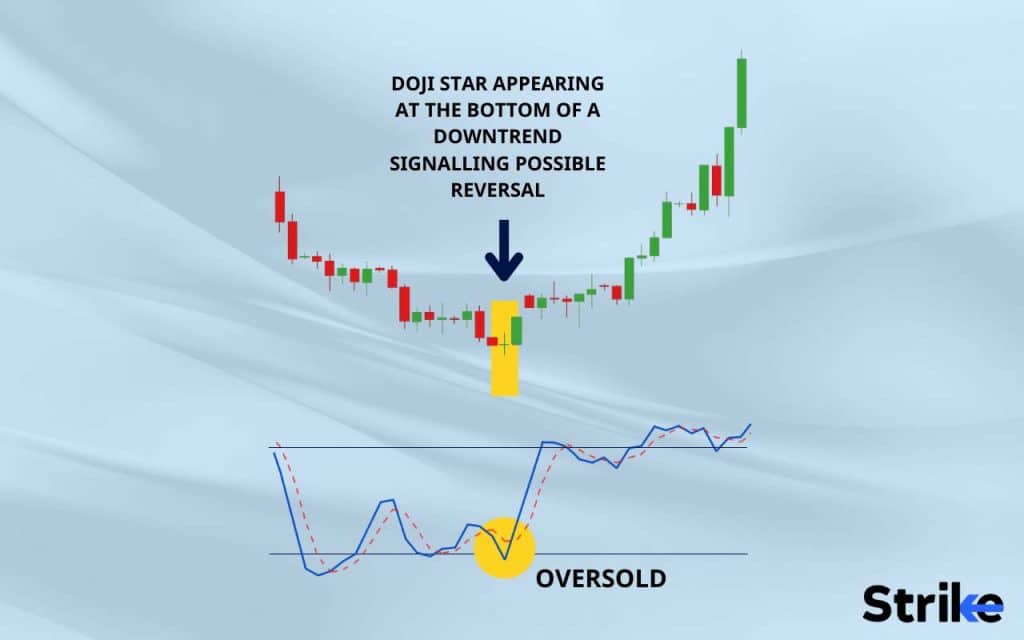
The image depicts a price chart in which there is an initial prolonged downtrend. At the end of the downtrend, a doji can be observed, signaling a possible bullish reversal. Before acting on the doji predictions, a technical indicator is used. Here a stochastic indicator is used. A stochastic indicator is a momentum-based indicator that studies and compares the closing prices of a security over a time period to predict overbought and oversold levels. An oversold level is suggestive of a bullish reversal and an overbought level indicates a bearish reversal. Here, as the image shows, the stochastic indicator points to an oversold level at the very position of the doji candlestick. The stochastic indicator thus supports the predictions of the doji candlestick.
- Applying trading strategies depending on the predicted trend
The last and final step to trading with stock doji patterns is to apply trading strategies depending on the doji predictions. Traders tend to hold on to the securities or buy more securities if the doji predicts a bullish reversal. Traders commonly resort to shorting if the trend predicted is a bearish reversal.
Using stop-loss orders is a common trading strategy used while trading in stock market using doji candlestick patterns. A stop-loss order is a predetermined clause that states that security must be bought or sold when it reaches a certain price, which is called the stop price.
What is an example of a Doji Candlestick Pattern used in Trading?
The price chart below details an example of how a doji candlestick pattern can be used in trading.
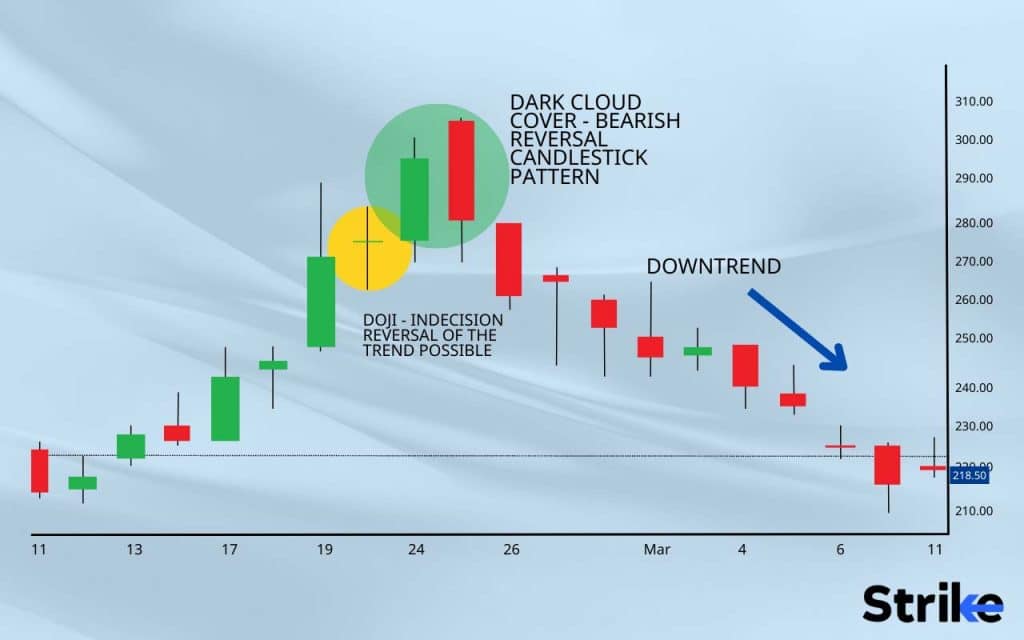
The example here depicts an initial uptrend, at the end of which a doji appears. The doji marks a point in indecision in the market where the open and close prices coincide. The two patterns that follow the doji confirm that the price reversal is imminent. As seen in the image the prices start to decline after the appearance of the doji. Upon seeing the doji, investors and traders must first apply other technical indicators like the stochastic indicator or the relative strength index (RSI) to confirm the trend prediction. Investors can apply their trading strategies once the trend has been confirmed. In this case, as the predicted trend is a bearish reversal, investors can resort to strategies such as shorting. Placing a stop-loss order just above the upper shadow is also a good way to prevent losses and gain profits while trading.
Is the Doji Candlestick Pattern profitable?
Yes, the doji candlestick pattern is profitable when used along with other technical indicators which complement the doji signals. Using the doji candlestick pattern in isolation is not very reliable as the doji candlestick patterns only occur very rarely.
Is a Doji Candlestick Pattern a Bullish Reversal?
No, a doji candlestick does not always indicate a bullish reversal. A doji candlestick can indicate a bearish or bullish reversal or indecision or pause in the trend. What a doji candlestick indicates depends on the type of doji pattern that is present as well as the context in which it presents itself.
What are the advantages of a Doji Candlestick?
The four main advantages of doji patterns are listed below.
- The ability to guide investors through possible trend reversals
The primary advantage of using doji candlesticks is their ability to guide investors through trend reversals. Doji candlesticks can predict upcoming bullish and bearish reversals depending on the type of doji pattern. Investors and traders can therefore use the information provided by the doji pattern to plan their trading strategies.
- The ease of identification
The second main advantage of doji patterns is their ease of identification. Doji patterns are easy to spot owing to their distinct shapes which are variations of the plus or cross symbol. They have almost no real body and have lower and upper shadows of varying lengths, making it easy for even beginners to spot them on the price chart.
- The accuracy
Doji patterns are reliable and accurate and provide accurate predictions regarding upcoming price reversals. Investors can also use other technical indicators to support the doji predictions and prevent losses.
- The ability to be used in different timeframes
The fourth main advantage of the doji pattern is that it can be used in various timeframes. Doji candlesticks work efficiently for time frames from one-hour ones to longer ones.
Other advantages of the doji candlestick pattern include its ability to point out trend highs and market uncertainty. Doji candlestick patterns also work very well with stock and forex markets.
What are the disadvantages of a Doji Candlestick?
The two main disadvantages of doji candlesticks are listed below.
- The tendency to produce false positives
The primary disadvantage of using doji candlesticks is their tendency to produce false positives. Doji patterns do not always signal a trend reversal. Soji can also signify a pause in the trend or indecision in the market sentiment. Investors usually use doji candlesticks along with other technical indicators to avoid incurring losses.
- The waiting period to confirm the upcoming market trends
The second main disadvantage of using doji patterns is that while using doji patterns investors have to wait for some time before confirming the trend. It is advisable to wait for the next one or patterns that follow a doji to confirm the upcoming trend signalled by the doji.
Other disadvantages of the doji include the requirement to identify the type of doji before interpreting its signals. The six different types can seem confusing to people. Doji candlesticks are also not very efficient when used in timeframes shorter than one duration. The rare occurrence of doji patterns also reduces their reliability.
What are other Types of Candlestick besides Doji?
There are totally more than 40 types of candlesticks and they are classified into three main categories which are bullish candlestick patterns, bearish candlestick patterns and continuation candlestick patterns.
The first type of candlestick is known as the bullish candlestick pattern. Bullish candlestick patterns are candlesticks which signal bullish trend reversals, Examples of bullish candlesticks include the hammer, piercing pattern, bullish harami, morning star, inverted hammer, tweezer bottom etc.
The second type is known as the bearish candlestick pattern. Bearish candlestick patterns signal bearish trend reversals. Examples of bearish candlestick patterns are the hanging man, dark cloud cover, shooting star, evening star, bearish harami, tweezer top etc.
The third type is the continuation candlestick pattern. Continuation candlestick patterns signify the continuation of the existing trend. Examples of continuation candlestick patterns include doji, spinning top, high wave, falling window, rising three methods, falling three methods etc. Doji candlesticks also signal bearish and bullish reversals sometimes.
What is the difference between a Doji Candlestick and a Spinning Top Candlestick?
A spinning top candlestick is similar to a doji candlestick, but it has a larger body when compared to a doji candlestick. A candlestick in which the body is up to 5% of its entire length is classified as a doji, and anything that exceeds the 5% mark is considered a spinning top. Spinning tops also don’t always signal a price reversal, and sometimes they can signal a weakening trend. Doji candlesticks, on the other hand, signal trend reversals, or pauses and indecision in the market.








![85 Common Stock Market Terminologies for Dummies [Updated List for 2026] 64 85 Common Stock Market Terminologies for Dummies [Updated List for 2025]](https://www.strike.money/wp-content/uploads/2025/04/Popular-Stock-Market-Terms-for-Beginners-Banner.png)










No Comments Yet.